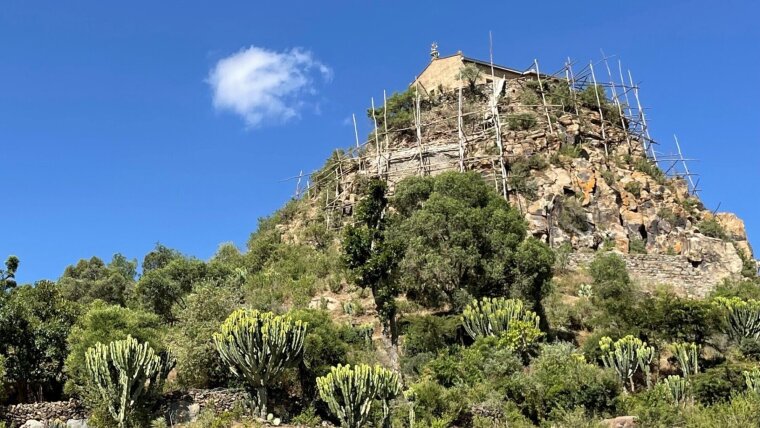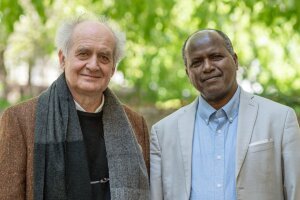
- International Affairs
- Research
Published: | By: Ute Schönfelder
Prof. Dr Norbert Nebes from the University of Jena and Prof. Mulugeta Feseha from the University of Addis Ababa (from left) are documenting archaeological sites in the "Ethiopian Heritage Digital Atlas" (EHDA).
Image: Nicole Nerger (Universität Jena)Ethiopia in North Africa: In the province of Tigray, along ancient trade routes where gold, ivory, ebony and incense were traded for centuries, past cultures have left countless traces. There are rock paintings more than 5,000 years old, monumental temples of the Ethio-Sabaean culture from the 1st millennium BC, evidence of the late antique Aksum kingdom or spectacularly situated Christian churches carved into the red sandstone.
An international team from the University of Jena, the German Archaeological Institute (DAI), Addis Ababa University and the Ethiopian Department of Antiquities has been compiling the Ethiopian Heritage Digital Atlas (EHDA) since 2022 as part of a project funded by the Gerda Henkel Foundation. The atlas maps and bundles information on around 1,700 archaeological, palaeo-anthropological and historical Christian sites in Tigray. The aim of the web-based atlas, which has now been completed, is to document Ethiopia's cultural monuments so that they can be better preserved, says Prof. Dr Norbert Nebes from the Research Centre Ancient South Arabia and Northeast Africa at the University of Jena, who led the project.
Sites are threatened by various risks
The team's main cooperation partner on site is Prof Mulugeta Feseha from Addis Ababa University. He names the challenges for the team's work. “The sites are threatened by various risks, such as climate change, which increases erosion and flooding, infrastructure measures and, last but not least, the war events of recent years.” Looted excavations are also a significant problem. In addition, many of the ancient sites now have new buildings, such as churches, built over them. “People often don't even know which foundations they stand on.”
The heart of the EHDA is a geoinformation system that records sites, monuments and objects and links them to archaeological and geographical information on a map. Together with photos, aerial and satellite images, information from museum and art trade databases and research data, the atlas has grown into a comprehensive register of regional cultural sites.
Familiar and new sites and evidence
In addition to familiar sites, the EHDA also includes new, previously unknown archaeological sites. “There are a lot of them,” says Dr Wolbert Smidt from the Research Centre Ancient South Arabia and Northeast Africa at the University of Jena. It is not uncommon for the researchers to receive information from the local population about ancient inscriptions that have been found in residential or commercial buildings, for example, some of which are two and a half thousand years old.
Smidt reports on a recent case: a church from the 6th to 7th century AD on a hill not far from Yeha, the site where Nebes and the Jena team have been working with the DAI for years on excavations of the Sabaean culture. “The church stands on old foundations, the hill is an ancient place of worship,” says Smidt. Due to the war in recent years, the area was not sufficiently protected and heavy rainfall led to part of the hill slipping away.
The ancient foundations uncovered in the process also revealed a previously unknown Sabaean inscription on a stone block. This is now being analysed by Jena epigraphist Norbert Nebes before it is to be published together with the Ethiopian team. According to the team, they will continue their research and endeavours to preserve the millennia-old cultural artefacts even after the current project has been completed.
